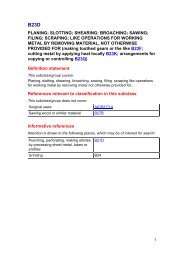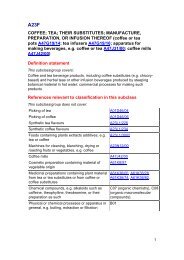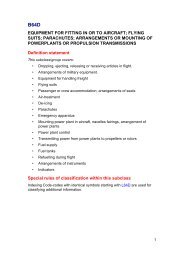A61K - Cooperative Patent Classification
A61K - Cooperative Patent Classification
A61K - Cooperative Patent Classification
Create successful ePaper yourself
Turn your PDF publications into a flip-book with our unique Google optimized e-Paper software.
CPC - <strong>A61K</strong> - 2013.07 - page 69<br />
<strong>A61K</strong> 49/06 . Nuclear magnetic resonance (NMR) contrast preparations ; Magnetic resonance<br />
imaging (MRI) contrast preparations<br />
NOTE<br />
-<br />
characterised only by the (inorganic) MRI-active nucleus, e.g. 129Xe<br />
<strong>A61K</strong> 49/08 . . characterised by the carrier<br />
<strong>A61K</strong> 49/085 . . . { conjugated systems }<br />
<strong>A61K</strong> 49/10 . . . Organic compounds<br />
NOTE<br />
-<br />
characterised by the carrier carrying the MRI-active nucleus, e.g. inorganic<br />
carrier]<br />
NOTE<br />
-<br />
The MRI-active nucleus being complexed to a complex-forming compound<br />
(e.g. chelating group) or being covalently linked to a molecule, which being<br />
further covalently linked or conjugated to a carrier, e.g. polymer.<br />
<strong>Classification</strong> being also made according to the nature of the carrier, e.g.<br />
[Gd3+]DOTA-polymer to be classified in <strong>A61K</strong> 49/085 and in the<br />
appropriate <strong>A61K</strong> 49/12 adequate subgroup<br />
NOTE<br />
-<br />
the carrier being an organic compound, e.g. 13C-labelled molecule or<br />
perfluorinated alkane, used as MRI in vivo probe, or a small organic<br />
molecule, e.g. a sugar, linked to a Gd-chelate<br />
<strong>A61K</strong> 49/101 . . . . { the carrier being a complex-forming compound able to form MRI-active<br />
complexes with paramagnetic metals }<br />
NOTE<br />
-<br />
In the <strong>A61K</strong> 49/101 subgroups, the MRI-active nucleus being<br />
complexed to a complex-forming compound, e.g. chelating group.<br />
<strong>Classification</strong> being made according to the nature of this<br />
complex-forming agent, if it being either an uncommon or new<br />
complexing agent (not the usual DTPA, DOTA, DOTP, etc...groups)<br />
that forms the real contribution to the claimed MRI invention, or if it<br />
being not conjugated to any further molecule, e.g. which being not<br />
conjugated to a polymer, peptide, protein or antibody. In that latter<br />
case, the MRI probe being e.g. a paramagnetic metal chelate]<br />
<strong>A61K</strong> 49/103 . . . . . { the complex-forming compound being acyclic, e.g. DTPA }<br />
<strong>A61K</strong> 49/105 . . . . . . { the metal complex being Gd-DTPA }<br />
<strong>A61K</strong> 49/106 . . . . . { the complex-forming compound being cyclic, e.g. DOTA }<br />
<strong>A61K</strong> 49/108 . . . . . . { the metal complex being Gd-DOTA }<br />
<strong>A61K</strong> 49/12 . . . . Macromolecular compounds<br />
NOTE





